Our work is informed by the Government’s commitment to genuine partnership with First Nations peoples for better outcomes.
Our key activities over the next 4 years will be:
- Lead and coordinate the National Agreement on Closing the Gap.
- Implement the Uluru Statement from the Heart.
- Enhance economic outcomes for First Nations peoples.
- Support early childhood development and wellbeing, and First Nations peoples educational participation and attainment.
- Improve mental health, emotional and physical wellbeing and safety.
- Maintain cultural expression and conservation, and support First Nations participation in policy development and decision-making.
- Enhance regional governance and improved partnerships with communities.
- Evaluate the NIAA’s programs.
Within each of these key activities there are areas of focus that are outlined in further detail below.
National Agreement on Closing the Gap
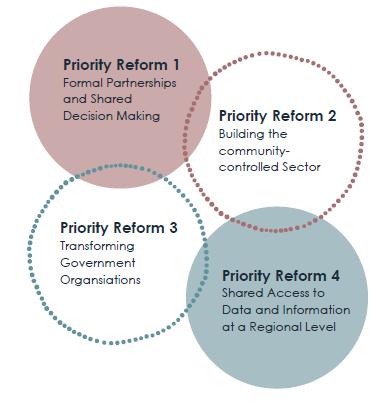
Under the National Agreement, First Nations peoples work together with governments to:
- overcome the inequality experienced by First Nations peoples
- achieve life outcomes equal to all Australians.
This requires a shift in the way governments work. It means sharing the decision-making on the design, implementation, monitoring and evaluation of policies, programs and services.
The National Agreement was developed in partnership between all Australian governments and the Coalition of Peaks. The Joint Council on Closing the Gap meets at least twice a year to ensure all parties share accountability for the National Agreement.
The NIAA provides a central coordination point for the Commonwealth Implementation Plan and Annual Report to provide transparency and accountability for Commonwealth actions in support of the aspirations of the National Agreement. We play a key influencing role in supporting the Minister for Indigenous Australians on the Joint Council on Closing the Gap and representing the Australian Government in the Partnership Working Group to drive the implementation of the National Agreement. We will continue to work with other Australian Government agencies, particularly central agencies including the Department of the Prime Minister and Cabinet, to embed the 4 Priority Reforms across government and change how we work. Following the work of the Productivity Commission’s three-yearly review of the National Agreement in 2023, NIAA will work with other agencies across the Commonwealth and with state and territory governments to support better outcomes under the National Agreement.
Uluru Statement from the Heart – Voice, Truth, Treaty
The Uluru Statement from the Heart (the Uluru Statement) calls for:
- an Aboriginal and Torres Strait Islander Voice enshrined in Australia’s Constitution
- an independent Makarrata Commission to oversee a national process of truth-telling and agreement-making.
The Australian Government is committed to implementing the Uluru Statement. Our role is to provide support to government to progress this commitment.
A referendum proposing a change to the Constitution to recognise the First Peoples of Australia by establishing an Aboriginal and Torres Strait Islander Voice will be held on 14 October 2023.
Through the reporting period, the NIAA will work with Australian Government agencies and First Nations leaders and communities, as well as other stakeholders to prepare for the referendum and achieve the government’s commitment to implement the Uluru Statement.
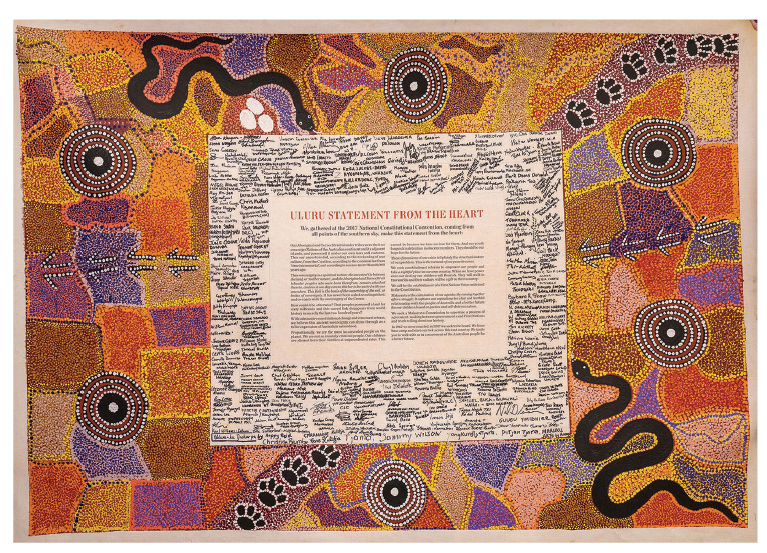
Uluru Statement from the Heart – Voice, Truth, Treaty
The Indigenous Advancement Strategy
The Indigenous Advancement Strategy (IAS) is the way the Australian Government funds and delivers a range of programs specifically for First Nations peoples. Since its establishment as an Executive Agency on 1 July 2019, the NIAA has administered the IAS, and through it has worked to improve the way the Australian Government does business with First Nations peoples to ensure funding achieves outcomes that improve the lives of First Nations peoples.
Our IAS investment is targeted to align with Closing the Gap Outcomes and Priority Reforms. Our key focus areas include:
- The positive impact that education has on the future success of individuals, families and communities is clear. Children who go to school have better life outcomes.
- Under the Children and Schooling Program stream, IAS investment will deliver practical supports for children and students to reach their full learning potential. Funding will be provided to support around 210 providers nationwide delivering early of Aboriginal and Torres Strait Islander childhood services, including facilitated playgroups and community and family engagement activities. This will ensure First Nations children start school with the best chance of success. The NIAA will also review options to improve support for First Nations boarding students from rural and remote areas and support and provide $21.6 million to support boarding services.
- Employment, economic development and social participation improve the lives of families and communities. The right conditions and incentives need to be in place for First Nations peoples to participate in the economy and broader society.
- Growing up in a healthy and safe home and community is essential for families to thrive and reach their full potential. In particular, the violence that too many women and children face must be addressed.
- Under the Safety and Wellbeing stream, the IAS funds 104 programs valued at $177.8 million to address prevention, early intervention and justice reinvestment initiatives that seek to reduce the number of Aboriginal and Torres Strait Islander people and young people that come into contact with the criminal justice system. The program also funds $332.8 million in programs that enhance the safety and wellbeing of First Nations women, children and families including activities that support family violence prevention legal services and wrap around supports for victim-survivors and their families including crisis accommodation, counselling and community education.
The structure of the IAS supports working with Indigenous Australians, communities, industries, business and service providers. It allows for joint development of solutions at the regional and local level. Funded providers are expected to work closely with Indigenous communities in the design and delivery of projects.
The IAS is supported by the NIAA’s Regional Network, which positions senior decision makers close to the people and communities they work with. Staff in the Regional Network work closely with funded providers and communities to develop and implement local solutions to improve outcomes for Indigenous Australians.
Territories Stolen Generations Redress Scheme
The Territories Stolen Generations Redress Scheme continues to be a high priority for us. The Scheme, which commenced operations on 1 March 2022, received 1,173 applications, and made payments to 561 stolen generations survivors totalling $45,744,250 during the period 1 March 2022 to 30 June 2023.
The Scheme is survivor-focused, trauma- informed and culturally sensitive. We will continue to work closely with Stolen Generations survivors and organisations, key stakeholders and government agencies. We established and sought ongoing advice from the Scheme’s External Advisory Board.
A Personal Acknowledgement is being delivered to eligible survivors who have asked for one. It is an important part of redress and gives each survivor a chance to:
- have their story about the impact of their removal acknowledged by a senior official in government
- receive an authentic and personalised acknowledgement of their removal and resulting trauma.
The process helps a person’s healing journey. In addition, it builds awareness and understanding of the Stolen Generations and associated intergenerational trauma at senior levels across the APS. It also contributes to Closing the Gap Priority Reform Three – Transforming Government Agencies.
So far, a total of 65 acknowledgements have been requested. A key focus of this reporting period is to make sure we have the resources to respond effectively. We will extend the pool of senior government officials to deliver Personal Acknowledgements.
Caring for Country – Rangers and Indigenous Protected Areas
Supporting First Nations peoples to care for and connect with Country delivers positive cultural, environmental, economic and wellbeing outcomes and contributes to our efforts to Close the Gap.
The Indigenous Rangers Program (IRP) and the Indigenous Protected Areas (IPA) support First Nations peoples to work on Country.
The programs:
- support cultural obligations to care for Country
- create jobs and support social and economic development in communities
- build the Indigenous land and water management sector
- develop leadership skills in the community
- protect Australia’s natural environment and cultural heritage through the IRP
- help us meet Australia’s international treaty obligations to conserve biodiversity.
These programs develop stronger cultural and community capital, bringing broader recognition of traditional knowledge and cultural practices in land and water management.
Indigenous Ranger Programs
The Australian Government funds 128 ranger groups through the IRP. Over the next 5 years, we will work with Indigenous ranger organisations to deliver $544.0 million in grants that have already been committed to supporting around 1,900 First Nations jobs.
Another $575.5 million will double the number of rangers and promote gender equality in ranger positions by the end of the decade. It will create new ranger positions and establish new ranger groups. First Nations community-controlled organisations will be able to get support to care for Country. This will be the first open competitive opportunity for ranger funding in more than 10 years.
We have also extended the Murray-Darling Basin Indigenous River Rangers program to 30 June 2026. Total funding for this program is now $14.6 million. This will support 5 organisations with up to 30 full time equivalent staff to manage and restore waterway health across the Murray-Darling Basin.
We are developing a National Indigenous Rangers Sector Strategy. Led by First Nations peoples, the strategy is supported by a cross-jurisdictional National Action Plan.
The strategy aims to strengthen the cultural, environmental, social and economic benefits of existing ranger programs.
Indigenous Protected Areas
The IPA program funds 82 dedicated IPAs for more than 50% of Australia’s National Reserve System. We manage these IPAs with the Department of Climate Change, Energy, the Environment and Water (DCCEEW) and Traditional Owners.
Another 28 IPA projects are in their consultation phase.
We will deliver funding agreements to manage 10 Sea Country IPAs and increase investment in IPAs by $10 million per year.

Warlpiri and Luritja participants on the mala trip. Photo: Central Land Council
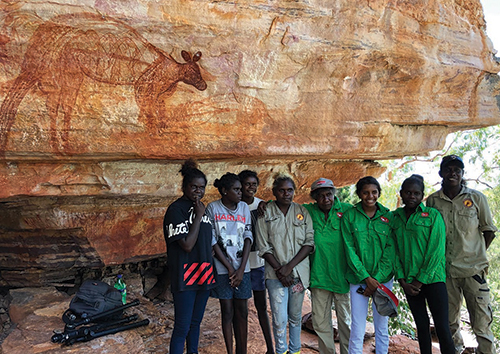
Daluk (women) rangers teaching Nawarddeken Academy students how to document rock art sites 2018. Photo: Nawarddeken Academy
Addressing incarceration rates of Adults and Youth
First Nations adults and youth are over-represented in the criminal justice system. We influence other agencies by sharing our collective evidence in delivering strengths-based, trauma-aware and healing-informed approaches to embed the Closing the Gap Priority Reforms and achieve progress towards targets 10 and 11 (adults and youth are overrepresented in the criminal justice system).
We partner with First Nations peoples and organisations, and our Australian Government and jurisdiction partners, including the Attorney-General’s Department to:
We do this by understanding the evidence-base and funding strengths-based, trauma-aware and healing-informed approaches, improving social and emotional wellbeing through connection to land, culture, and Country.
We will work with the Attorney-General’s Department to:
- ensure that justice reinvestment initiatives are developed in partnership with First Nations communities3
- advocate for approaches that address the drivers of contact with the criminal justice system focussing on prevention, early intervention and justice reinvestment including through IAS funded programs such as youth diversionary programs, youth camps and community night patrols and improving social and emotional wellbeing through connection to land, culture, and Country
- strengthen community and peak organisation capability to lead justice reinvestment initiatives and improve legal, policy and program settings, including through the Justice Policy Partnership4.
Supporting Housing and Infrastructure
The Australian Government is implementing significant housing reform.
We work in collaboration across the Commonwealth, with states and territories, and First Nations stakeholders to deliver on housing commitments to get the best outcomes for First Nations people, including collaboration with the Treasury and the Department of Social Services through:
- the development of major housing policies and programs, including the Housing Australia Future Fund and the National Housing and Homelessness Plan
- working towards ensuring Aboriginal and Torres Strait Islander people secure appropriate, affordable housing that is aligned with their priorities and need, as outlined in the National Agreement.
We also work with the Northern Territory (NT) Government to deliver remote housing in the NT, by administering remote housing agreements with the NT Government, providing funding through the one-year Remote Housing Agreement and through the Restoring Funding for NT Homelands Agreement. This funding provides immediate support to the areas of greatest need in the NT, where overcrowding is highest. We are working collaboratively with Aboriginal Hostels Limited (AHL) to ensure temporary accommodation options are available across Australia for First Nations people who need to access to this vital service. We also have policy oversight of Indigenous Business Australia’s (IBA) Indigenous Home Ownership Program and work with IBA to support First Nations’ home ownership.
We influence on policy and project development and program management for essential services and telecommunications in remote First Nations communities. We work with the Department of Infrastructure, Transport, Regional Development and Communications and the Arts (DITRDCA) on the Community Infrastructure and Digital Inclusion targets under the National Agreement on Closing the Gap, to enable Aboriginal and Torres Strait Islander people to have access to services, information and participate in informed decision-making regarding their own lives.
We invest in essential services infrastructure and telecommunications where there are gaps in service delivery and infrastructure for remote communities.
Far western town of Eula, Queensland. Photo: Getty Images
Central Australia Response
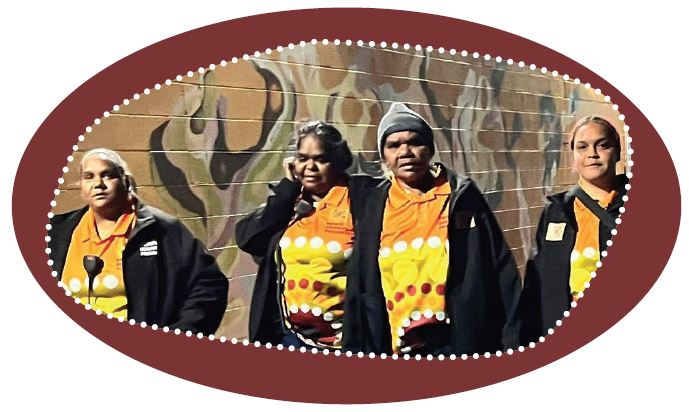
Arrernte community female patrollers on duty Photo: NIAA
On behalf of the Australian Government, we are working to achieve the long-term, sustained change that Central Australian communities need, in partnership with Central Australian communities, the NT Government, the Central Australian Regional Controller, and an Aboriginal Leadership Group.
We have appointed a senior executive Central Australia Implementation Lead to drive delivery of the Australian Government’s investments and demonstrate our deep commitment to doing things differently in Central Australia. This role is leading and overseeing the development and delivery of the Australian Government elements of the Central Australia Plan and provide advice on how to solve implementation challenges over the next two years.
A Better, Safer Future for Central Australia (Central Australia Plan) is the Australian Government’s response to increased reports of alcohol-related harm in Alice Springs. It includes $298.8 million for community safety, health, justice reinvestment, education, infrastructure to address the challenges of social disadvantage Government in Central Australia. Some of this is earmarked specifically for children and young people. We know that by investing in children and youth, there will be better long-term health, social and wellbeing outcomes for families and communities.
The landmark funding package being delivered under the Central Australia Plan works in tandem with new alcohol restrictions imposed by the NT Government across the region. Alcohol takeaway sales in Alice Springs are limited and new legislation reverts Alice Springs town camps and communities in Central Australia to dry zones.
To ensure First Nations peoples are at the centre of our decisions, we are guided by:
- the voices of community members right across Central Australia. Together with the NT Government, we have visited Central Australia talking to over 22 different communities about their needs and priorities
- the Office of the Central Australian Regional Controller (OCARC)
- the Aboriginal Leadership Group (ALG).
The ALG brings together remote community members, Traditional Owners, representatives from the region’s youth and elders along with key Aboriginal service providers from Alice Springs to provide independent advice on the Central Australia Plan.
Boosting First Nations Employment
Through strengthening mainstream services

We will continue to work across the APS to ensure employment services reforms underway in 2023-24 build pathways to jobs for First Nations people. Reform processes include the Employment White Paper led by Treasury (due in September 2023), the response to the House Select Committee on Workforce Australia Employment Services led by the Department of Employment and Workplace Relations (DEWR) (report due 30 November 2023), and a new voluntary program to support parents and carers into work, also led by DEWR (to replace ParentsNext from 1 July 2024).
To do this, we are continuing to develop better data and evidence with other Government agencies, informed by our consultations with First Nations people and on the outcomes of our programs. We will continue to support First Nations voices to participate in policy and program design and implementation. We will ensure that the forthcoming remote jobs program (to replace the CDP) and Indigenous Skills and Employment Program (ISEP), align with and complement other employment supports in place, such as Workforce Australia and Disability Employment Services.
Through a New Employment Program for Remote Australia
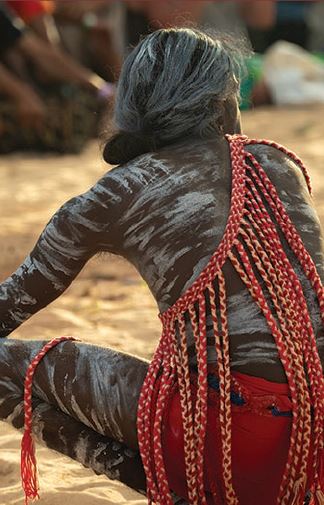
Performer at Garma Festival 2023
The Australian Government has committed to replacing the CDP with a new approach to remote employment that provides real jobs, proper wages and decent conditions, designed in partnership with First Nations peoples. The new approach will aim to give more control to communities to determine local projects that enhance First Nations peoples’ job prospects and economic opportunities as part of a new remote jobs program.
We will continue to collaborate with First Nations communities and other key stakeholders to support jobseekers in remote areas. The Government’s trials to help inform the design of the new program are underway and will continue until 31 October 2024. These trials are already delivering promising results, with over 1,300 participants being directly placed in jobs and overall job placements for CDP participants increasing by 14% since the first trial began in November 2022. The trials have also supported the creation of 26 new enterprises to deliver important services and fill servicing gaps in remote communities. These involve local people being paid proper wages to deliver services to their communities, such as, care, hospitality, small manufacturing and retail, art and culture, and municipal, gardening and cleaning.
Strengthening First Nations Representation in the Australian Public Service
The Australian Government is building a stronger APS. The aim is to deliver better outcomes for communities and be a model employer that provides a fair and inclusive workplace.
Part of this is a commitment to:
- increase First Nations representation in the Senior Executive Service (SES) across the APS
- boost First Nations employment across all levels in the APS from 3.5% to 5% by 2030.
Increasing First Nations employees in the SES ranks will increase our cultural capability and that of the broader APS as well as focusing on developing our talent pipeline. Increased participation gives First Nations employees a stronger say on workplace matters that affect them. It also helps build an APS workplace that is free from racism and a workplace that embeds and practices meaningful cultural safety.
To deliver this commitment, we are partnering with the:
- First Nations Unit in the Australian Public Service Commission (APSC).
- APS Reform Office at the Department f the Prime Minister and Cabinet.
In addition to this commitment, we are working across the APS to boost First Nations employment, through a range of attraction, retention and career development activities, including the following:
- First Nations employees across the APS can take part in our Indigenous Development and Employment program.
- We lead a program offered across the APS for First Nations employees to study a Graduate Certificate in Management.
- Our employees can take a new micro certification program with Melbourne University. It explores the knowledge, skills and dispositions needed to work with both government and First Nations peoples.
- Working in partnership with the APSC to implement the refreshed cultural capability framework as an important feature of implementing Priority Reform 3 in the APS.
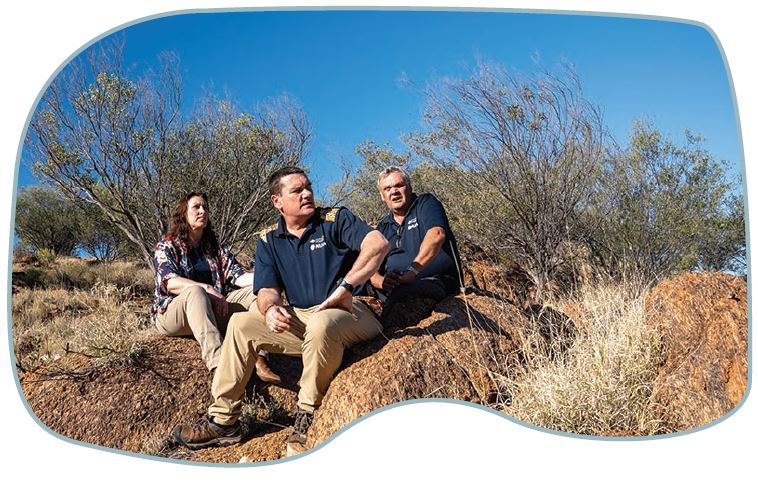
NIAA Central Australia team Location: Olive Pink Botanic Garden, Alice Springs, NT Photo: NIAA
Boosting Indigenous Participation in Australia’s Top 200 businesses
The Australian Government will work with Australia’s top 200 businesses to:
- publically report on First Nations employment levels, in line with reporting requirements for gender balance on boards
- elevate employment levels of First Nations working age Australians to levels consistent to share of population by 2030.
To deliver this commitment, we are working with stakeholders including the Business Council of Australia (BCA) and the Workplace Gender Equality Agency (WGEA) to identify new ways to strengthen public reporting and leverage proven approaches to lifting First Nations recruitment, retention and career advancement.
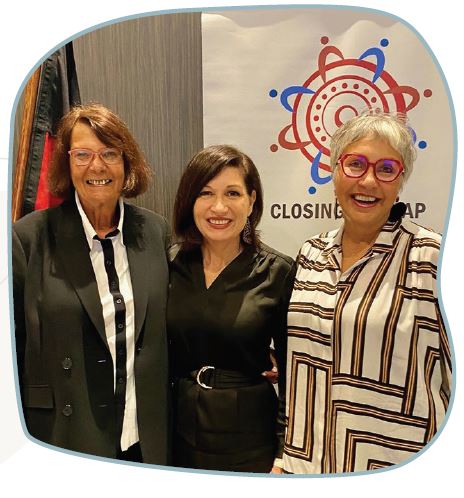
Pictured left to right: Pat Turner, Lead Convener, Coalition of Peaks, Leeanne Enoch, MP, Queensland Minister for Treaty, Minister for Aboriginal and Torres Strait Islander Partnerships, Minister for Communities and Minister for the Arts and Jody Broun, CEO, NIAA at the Partnership Working Group (PWG) meeting to discuss the National Agreement on Closing the Gap and the implementation of the four Priority Reforms Photo: Bianca Brim, Coalition of Peaks
These activities represent a shared commitment to ensuring the strong economic participation and development of Aboriginal and Torres Strait Islander people and communities, in line with the National Agreement on Closing the Gap.
Reconciliation
Our vision for reconciliation is for Australians to work together to support the aspirations of Aboriginal and Torres Strait Islander peoples, their living cultures, stories and songlines, and acknowledge the historical injustices against Aboriginal and Torres Strait Islander peoples to enable reconciliation.
Through our Stretch Reconciliation Action Plan 2022–2025, we continue to drive positive change within the NIAA. Building meaningful partnerships and culturally appropriate practices continues to be the centrepiece of our reconciliation actions. An important step to support this change was taken when we committed to the Human Rights Commission’s ‘Racism. It Stops with Me’ campaign5.
Our First Nations Cultural Protocols Guide supports us as we:
- enable our staff to build respectful relationships with First Nations peoples
- deliver policies and programs across Australia in a culturally appropriate way
- work towards reconciliation.
We are the Agency responsible for leading activities across the Commonwealth that promote reconciliation. This means we take opportunities to share knowledge, resources and practical guides with other agencies so they can take their own initiatives to drive reconciliation at all levels.
Our cross-cultural learning framework, Footprints, supports staff to continually strengthen their cultural competence, including building their knowledge and understanding of Aboriginal and Torres Strait Islander cultures, peoples and histories through engaging in a wide range of activities. We are proud to share the Footprints Program with other agencies across the APS.
We play an important role by contributing to and providing secretariat support for the Indigenous Champions Network (ICN). The ICN is an advocacy body consisting of senior leaders from multiple Australian Government agencies. The main focus of the ICN is to promote good practice and collaboration between agencies that drives change and improves workplace outcomes for Aboriginal and Torres Strait Islander staff across the APS.
We also support the Garma Alumni, bringing together senior public officials who have attended the Garma Festival. The annual Garma Festival is Australia’s largest Indigenous gathering, a 4-day celebration of Yolŋu life and culture held in remote northeast Arnhem Land. The Garma Festival is hosted by the Yothu Yindi Foundation and showcases traditional miny’tji (art), manikay (song), bunggul (dance) and story-telling. The Garma Alumni is a forum for participants to share learning and insights, including how through their attendance at Garma they are leading change and driving reconciliation in their Agency.
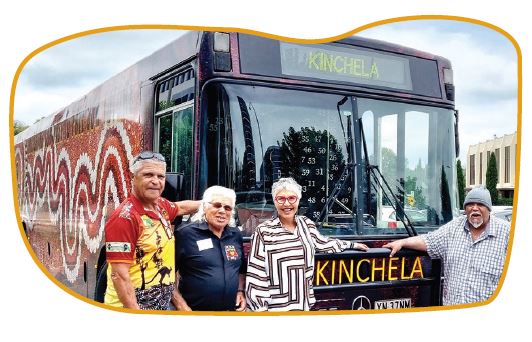
Jody Broun, CEO, NIAA, with the survivors of the Kinchela Boys Home as they travel in a Mobile Education Centre, reflecting on the Stolen Generations with the mission of healing and truth telling Photo: NIAA